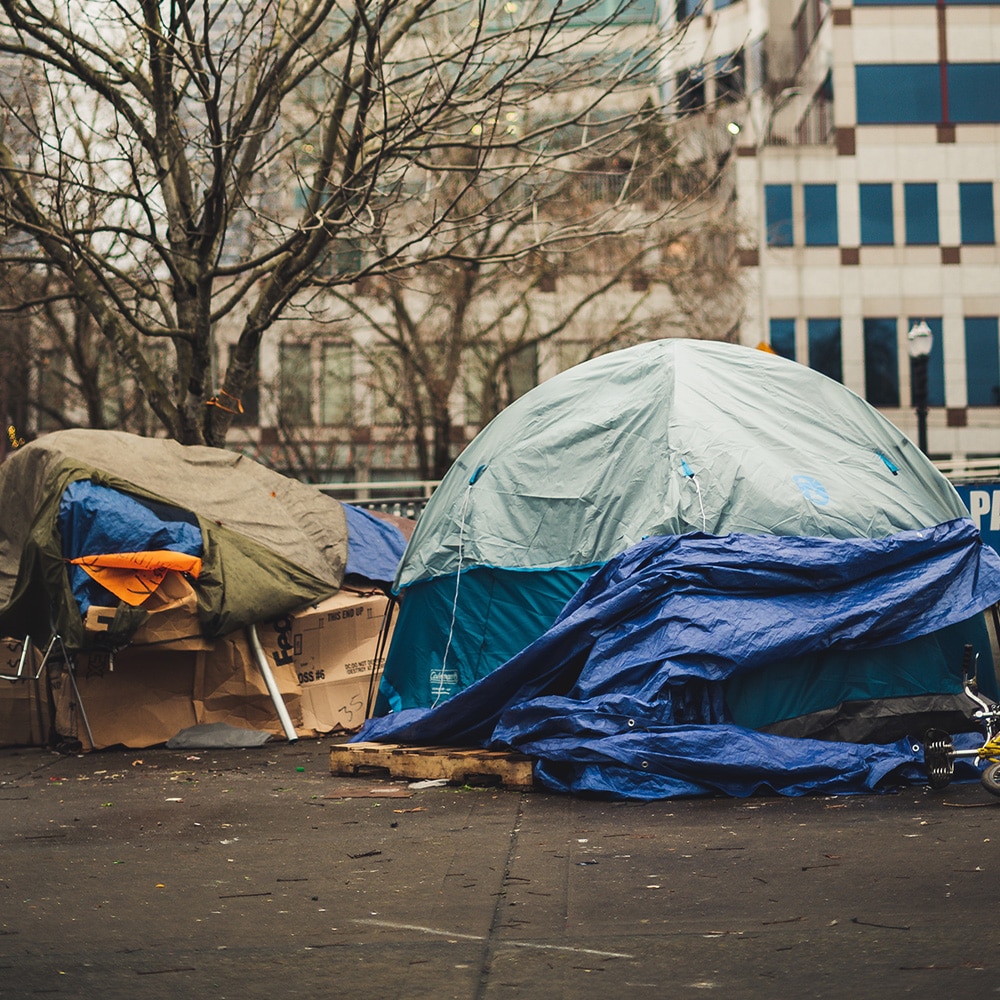In Portland, some neighborhood associations assist homeless residents, rather than rally to eject them
From Oregonlive
Updated: Mar. 27, 2021, 11:04 a.m. | Published: Mar. 27, 2021, 7:00 a.m.

By Nicole Hayden | The Oregonian/OregonLive
Tony Gonzales finds solace as he rests on a concrete space an arm’s reach from a downtown Portland church, its steeples stretching heavenward on either side. He sleeps in a gray and green tent, neatly tucked at the edge of the sidewalk, trying to be unobtrusive to passersby. His goal: to be invisible. To just make it safely through the night.
“I don’t really like it here. It’s uncomfortable. My situation, it’s embarrassing,” he said on a recent blue-sky Sunday. “At night I can hear people yelling and it bothers me. I wish they would stop.”
A lot of life squeezes into the four-square block section of downtown he now calls home. Archways of trees with spring buds. Red brick walkways. Buildings dripping with history. Tents that are temporary homes. And housed neighbors who, as they walk down the street to the hair salon or coffee shop, sometimes avert their eyes from things they find hard to see.
But there are also those who feel moved to help their neighbors experiencing homelessness – and want them to know they aren’t invisible.
“I think every neighborhood association should understand who their neighbors are,” said retiree David Dickson, who co-leads volunteer homeless outreach for the Downtown Neighborhood Association.
From Lents to Sunnyside to downtown, self-governed neighborhood groups are setting their sights on a new goal of filling homeless services gaps. They have organized trash clean-ups, free showers, laundry services, food and cold weather gear distribution and weekly wellness checks.
Gonzales appreciates the kindness neighborhood volunteers have shown him.
Such actions mark a distinct change in Portland. Historically, neighborhood associations from Overlook to Laurelhurst to Mt. Scott-Arleta expressed wariness or outright hostility to shelters or other communal living spaces for people experiencing homelessness existing within their bounds.

When the Sunnyside neighborhood found itself occupied by a large homeless community centered on its public school playground last year, however, the Sunnyside Neighborhood Association responded by, among other actions, launching a free shower program.
Hannah Wallace, who leads that project, said the work started after neighborhood residents elected a new association board last summer, resulting in “new blood” and “an attitude change.”
Dickson said the Downtown Neighborhood Association board similarly saw a changing of the guards last spring.
Typically in Portland, where neighborhood associations were granted city-conferred powers decades ago, these groups have focused on safety issues, litter and social activities like hosting movies in the park. “Not a lot have homelessness committees,” Dickson said.
Volunteers who’ve joined the new movement hope it will catch on across all of Portland’s 94 neighborhood associations. Currently, at least 15 groups are engaged in some sort of organized homelessness endeavor, according to a poll of neighborhood officials.
BOTTOMLESS NEED FOR OUTREACH
Every Sunday at 1 p.m., downtown residents Dickson and Stephanie Hansen, who was formerly homeless, meet outside of Hansen’s apartment near Southwest 10th Avenue and Main Street. They are one of 14 homeless outreach teams within the Downtown Neighborhood Association. Each has an assigned set of blocks to walk around once a week with a wagon full of granola bars, water, coffee, socks, blankets, hygiene products and more for people living on the street. Teams have been doing this since November.
“We provide survival items for folks, but it is equally important to build relationships and trust over time,” Dickson said. “We want them to know we are there to support them and we can provide information about mental health services, shelter, and to really just listen and be a good neighbor.”
Starbucks donates the coffee. The group buys half the gear with private donations. The other half is provided by the joint city and county supply warehouse.
The downtown association is currently the only neighborhood group that picks up supplies on a weekly basis, said Multnomah County communications director Julie Sullivan-Springhetti. The city spreads $2 million across all 94 neighborhood associations which can be used for any programming costs, including homeless outreach.
This past Sunday, Dickson and Hansen met right on schedule. The weather hinted at spring, enjoyable for a stroll around the neighborhood, but still too cold to comfortably live outside.
Dickson started walking, pulling the heavy red wagon that Hansen had packed full. Before they made it even half a block, a man gingerly stopped them and asked for water. He’s not homeless, rather he lives down the street in an affordable housing complex. But he was hungry and thirsty and low on cash. They handed him water, plus a bag filled with fruit and protein bars – they know the need reverberates further than just their houseless neighbors.
Within their few blocks, Dickson and Hansen walked past nearly 25 tents. They stopped to say hello at each. Darlene Garrett, who chairs the downtown association’s homeless outreach committee, estimates about 200 people are experiencing unsheltered homelessness in the downtown area, based on a count the association conducted. The outreach teams take notes and keep tallies each week as well.
“Knock-knock, anybody home?” Dickson called, leaning toward a blue tent covered in water-resistant layers to fend off the cold. “We have cold weather gear, socks and gloves.”
One woman said yes to coffee – two sugars and cream. Another man asked for a tad extra sugar if there was any to spare.
The wagon-toting duo continued walking. They compared notes on who they had seen recently and where others had moved on to. They recently connected one man to a free clothes bank to help him prepare for a job interview. They chatted about a mental health training they participated in, another initiative from the downtown group to help neighbors interact with neighbors.

Then Hansen pointed out burn marks on the sidewalk that crept up a disheveled tree. Her knowing face crinkled into worry. “See this darkness here,” she said. “This is from a tent fire. People just trying to stay warm.”
As Dickson and Hansen were about to turn a corner, a man named Jeffrey asked if they had any snacks. He is living off a disability check while he rooms at a halfway house for those recovering from mental health issues a block away.
He accepted a bag of food, then Hansen offered him socks.
“White socks! I love to wear fresh socks,” he exclaimed. “I hate walking around on old socks that feel like sandpaper.” The team handed him a second pair. He was exuberant.
Finally, the two came upon Gonzales’ tent. Dickson yelled out his scripted “knock-knock,” and was initially brushed off. But Gonzales and his neighbor in the next tent over both perked up with the offer of blankets.
“Whatever you guys want to give us, we need,” Gonzales said, thanking the team and asking how their day was going.
Dickson saw that Gonzales didn’t have a cover over his tent like most campers. He rooted through the wagon and pulled out a blue tarp and an insulation blanket. He instructed: “put this blanket between your sleeping bag and the ground.” The blanket will keep the sleeping bag from being soaked in condensation and the tarp will provide a stronger layer against wind and rain.
Gonzales was thankful – he had never before seen outreach workers in his neighborhood.
“I know there are so many programs available to help us, but I really appreciate that they came to us,” Gonzales, 40, said. “I am really shy and sometimes feel overwhelmed going to a resource center to ask for help. I feel embarrassed to have to ask … I think it’s really awesome that they put forth the effort to come to us.”
NEXT: TACKLING TRASH
About 20 feet away and across the street from Gonzales’ spot sat a pile of trash. Or what appeared to passersby as trash. Garrett, the downtown homeless/houseless committee chair, asked Gonzales if he knew to whom the items belonged.
“The guy down there declared he was going to move out of his tent and start moving his stuff out the other day because he didn’t want it, but he is still living here and he keeps taking things back from the pile,” Gonzales told her. The team chose not to report the trash to the city since the items appeared to be someone’s belongings but said they would check back another day to see if residents wanted help cleaning up.
As the volunteers handed out socks and coffee, a frazzled security guard approached. The man, dressed in a black uniform, said he didn’t want to cause harm to those living along the sidewalk but asked Hansen if she could help him converse with the unsheltered residents about the litter accumulation.
The downtown group provides trash bags and reports piles of trash to the city when necessary. However, they never do so without talking to people living nearby first. What looks like garbage to one person could be someone’s prized possessions or last remaining memories of their life prior to losing housing.
But controlling weekly rubbish is the one challenge the downtown group’s members are struggling to wrap their minds around, Dickson said. It’s the next project the volunteers plan to tackle.

Other neighborhood groups have been faced with the same challenge. In Sunnyside, volunteers led a clean-up at the beginning of the year near Southeast 36th Avenue and Hawthorne Boulevard. They worked together with the area business district and a local business to rent a $400 Dumpsterfor a day. Volunteers first talked to two individuals who were living unsheltered in the area to make sure they were comfortable with the clean-up.
“We don’t want to see homeless individuals be pushed out, we just want regular trash pick-up,” said Wallace, leader of the neighborhood’s free showers project. “The two guys who were living there said it was wonderful we were cleaning up and asked how they could help.”
While housed neighbors have regular trash and recycling pick-up services, those living unsheltered largely do not. Additionally, while many neighborhood associations run litter pick-up programs, those groups aren’t equipped to address substantial waste that can comewith encampment living.
“I know the city is overwhelmed right now and they don’t have enough manpower, so we did what the city couldn’t do,” Wallace said. “This is what neighborhood associations have the potential to do.”
Wallace hopes eventually a nonprofit can provide more sustainable services than their group can, but they plan to continue doing regular trash clean ups in the meantime. “If the city would give us a Dumpster that they could cart away on a weekly basis, that would help us,” she said. “We have volunteers to do the actual trash pick-up, but no way to dispose of the trash.”
Organizations like SOLVE, which leads large trash pick-ups and coordinates removal, and Adopt One Block, which assigns volunteers to regularly pick up trash, can offer some assistance to the neighborhood groups. The city already coordinates with SOLVE, said Seraphie Allen, policy adviser to Mayor Ted Wheeler.
“Some neighborhood associations want (the city) to completely remove camps and want to know when we will be moving a site, but we will not engage in that way,” Allen said. “However, the element of direct outreach like the Sunnyside and Overlook neighborhoods have taken to create relationships with neighbors, we are very supportive of that.”
Nicole Hayden reports on homelessness for The Oregonian. Follow her on Twitter @Nicole_A_Hayden. Reach her at nhayden@oregonian.com or (810) 210-1561.

